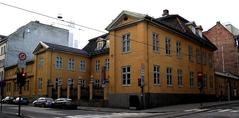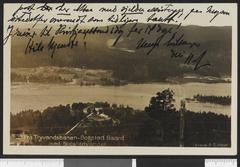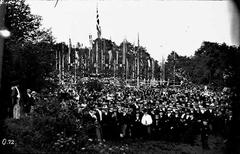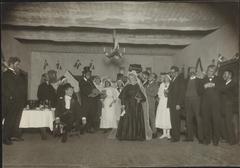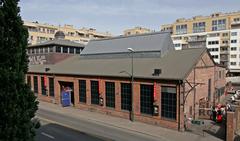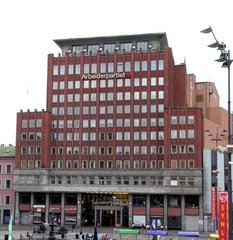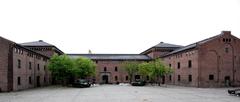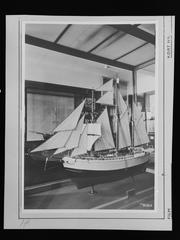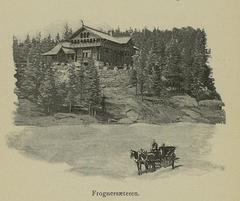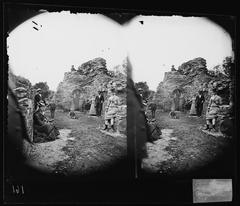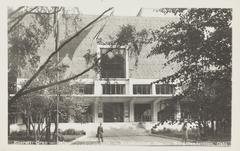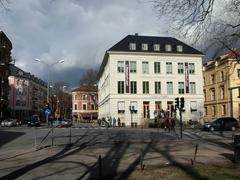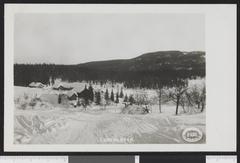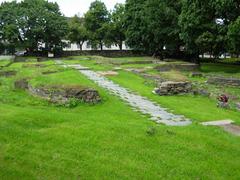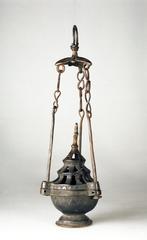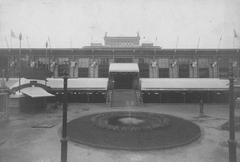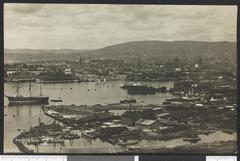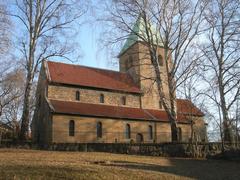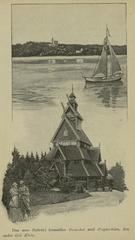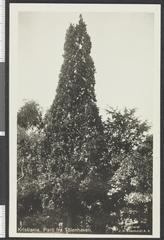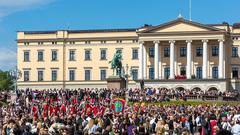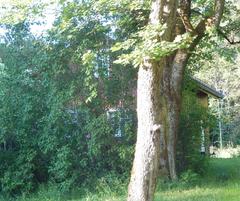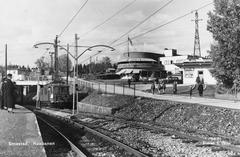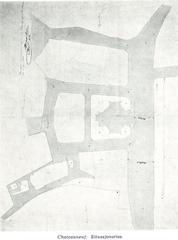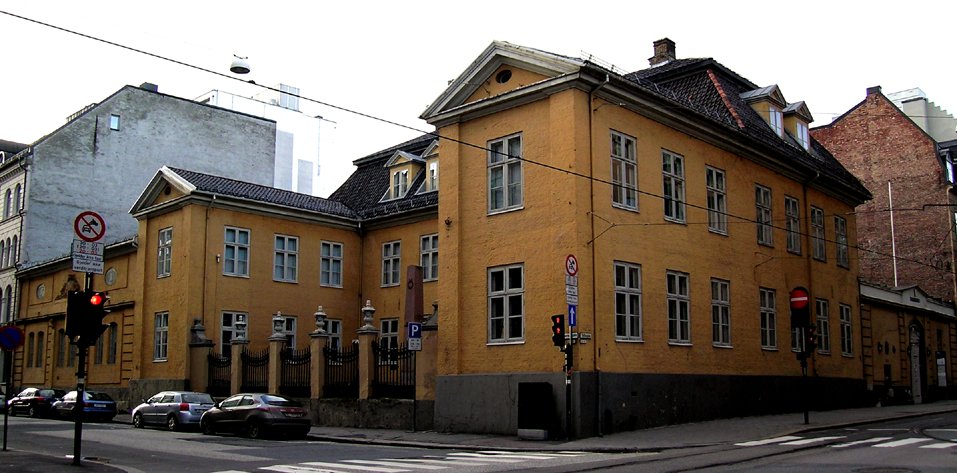
Krigsskolen Visiting Hours, Tickets, and Oslo Historical Sites Guide
Date: 14/06/2025
Introduction: Krigsskolen’s Enduring Legacy
Krigsskolen, or the Norwegian Military Academy, stands as one of Oslo’s most significant historical and architectural landmarks. Situated at Tollbugata 10 in the heart of the Kvadraturen district, the building has witnessed centuries of Norway’s military, civic, and urban development. Established in 1750 by royal decree, Krigsskolen is among the world’s oldest officer training schools, having shaped generations of military leaders and contributed to pivotal national events, including the 1814 constitutional assembly (Norwegian Military Academy - Official Site).
This comprehensive guide details the academy’s history, architectural highlights, visitor information—including opening hours and ticketing—preservation efforts, and practical travel tips. Whether you are a history enthusiast, architecture lover, or simply exploring Oslo’s best historical sites, Krigsskolen offers a rich, multifaceted visitor experience.
Table of Contents
- Historical Overview: Foundation and Early Years
- Architectural and Urban Significance
- Role in Norwegian Military and Civic History
- Educational Innovations and Social Impact
- Transition, Relocation, and Preservation
- Visitor Experience: Hours, Tickets, and Tours
- Accessibility and Travel Tips
- Nearby Attractions
- Ongoing Preservation and Future Plans
- FAQ
- Conclusion
- References
Historical Overview: Foundation and Early Years
Krigsskolen was founded in 1750 by King Frederik V of Denmark-Norway as a response to the evolving needs of 18th-century European military organizations. The institution’s early curriculum centered on mathematics, engineering, and military tactics, reflecting contemporary priorities for a professional officer corps (Norwegian Military Academy - Official Site). Its original home at Tollbugata 10, already an established city palace from the 1630s, was ideally located near Akershus Fortress and key civic buildings, integrating military education with the administrative life of Christiania (now Oslo).
The building’s origins as a patrician residence for Chancellor Jens Bjelke and later prominent figures like Caspar Herman von Hausmann underscore its deep-rooted civic and social significance (Open House Oslo).
Architectural and Urban Significance
Tollbugata 10 is a rare example of pre-1800 urban architecture in Oslo, notable for its restrained neoclassical exterior and rich Rococo interiors. The property’s transformation in the 1760s endowed it with elegant design elements, including:
- Main Entrance and Courtyard: A monumental portal leads to a cobblestone courtyard, flanked by ancillary wings and a formal garden, all enclosed by original wrought-iron fencing (Forsvarsbygg).
- Interior Details: The building features ornate Rococo ceilings, the “Jaktrommet” (Hunting Room) with unique wall paintings, and a grand staircase with intricate ironwork.
- Urban Context: As one of the few surviving buildings from Oslo’s Kvadraturen grid, its enduring presence offers a tangible connection to the city’s early modern development (Wikipedia).
Role in Norwegian Military and Civic History
Krigsskolen played a pivotal part in Norway’s military history. Its alumni were instrumental in national milestones such as the Napoleonic Wars, the defense of Norway during the Swedish campaign of 1814, and the drafting of the Norwegian Constitution (Store norske leksikon). The academy’s progressive admission policies promoted social mobility and professionalization within the officer corps.
In addition to military leadership, Krigsskolen contributed to scientific and technical advancement, particularly in engineering and cartography, in partnership with Oslo’s civilian institutions.
Educational Innovations and Social Impact
From its inception, Krigsskolen was at the forefront of educational reform, admitting talented cadets regardless of social background—provided they met rigorous academic and physical standards. The curriculum expanded over time to balance technical instruction with leadership, humanities, and civic duties, producing well-rounded officers who often became prominent explorers, politicians, and academics.
Transition, Relocation, and Preservation
In response to growing needs, Krigsskolen relocated in 1899 to larger premises in Linderud, on the outskirts of Oslo (Forsvaret - Krigsskolen). Tollbugata 10 subsequently served as government offices and later as a commercial property, but its historical legacy was preserved.
Today, Tollbugata 10 is a protected cultural heritage site, with plaques and interpretive displays commemorating its significance (Byantikvaren Oslo). The building is open to the public primarily during cultural heritage days and special guided tours.
Visitor Experience: Hours, Tickets, and Tours
Opening Hours and Admission
- Regular Access: Tollbugata 10 is not open daily. Public access is typically available during special cultural events—such as Oslo Open House and designated heritage days (Open House Oslo).
- Tickets: Entrance is usually free during these events, though some guided tours or exhibitions may require advance ticket booking.
- Guided Tours: Expert-led tours are offered during open events and occasionally by special arrangement. These tours provide valuable context and access to select interiors.
- Current Status: For detailed schedules and ticketing information, consult the Oslo Visitor Centre.
Accessibility
- Mobility: The surrounding Kvadraturen area is wheelchair accessible. The building’s historic interiors have limited accessibility, but efforts are ongoing to improve access for all.
- Visitor Amenities: The area offers level pavements, nearby public transport stops, and interpretive signage.
Photography
Photography of the exterior, gardens, and memorial features is encouraged. Inside, photography may be restricted to protect delicate interiors—please follow posted guidelines.
Travel Tips
- Getting There: Tollbugata 10 is centrally located. The nearest tram stop is “Stortorvet,” just a short walk from Oslo Central Station.
- Parking: Limited on-street parking is available; public transport is recommended.
- Combine Visits: Plan to visit nearby sites like Akershus Fortress, Oslo Cathedral, and the Kvadraturen district for a comprehensive historical tour.
- Walking Tours: Self-guided routes and group walks are available through platforms like Oppdag Kvadraturen.
Nearby Attractions
- Akershus Fortress: Medieval castle complex with panoramic city and fjord views.
- Oslo Cathedral: Oslo’s main church, rich in art and history.
- Kvadraturen District: The oldest part of modern Oslo, offering museums, galleries, and cafés.
- Aker Brygge and Bjørvika: Modern waterfront areas perfect for dining and leisure.
Ongoing Preservation and Future Plans
Recent Ownership and Restoration Efforts
In February 2021, Tollbugata 10 was transferred from the Ministry of Defence to Stiftelsen Den Gamle Krigsskole (The Old Military Academy Foundation), safeguarding its public stewardship (Byantikvaren Oslo). Restoration needs are significant—structural rehabilitation, conservation of artistic features, and upgrades for accessibility are all planned, with an estimated cost of 350 million NOK.
Vision for the Future
The foundation envisions a vibrant, sustainable future for Tollbugata 10, including:
- A living museum of Norwegian military and educational history.
- Event and conference facilities.
- Community spaces for lectures, workshops, and cultural activities.
- Commercial office space to support ongoing operations.
Funding is being sourced through state grants, private sponsors, and operational revenues, with full restoration expected to take several years.
Frequently Asked Questions (FAQ)
What are the visiting hours for Krigsskolen/Tollbugata 10?
Public access is generally limited to cultural heritage days and special events. Check the Oslo Visitor Centre for the latest information.
Is there an entrance fee or are tickets required?
Exterior viewing is always free. Some events or tours may require tickets.
Is the site wheelchair accessible?
The surrounding area is accessible, but interior access is limited due to historic features.
Are guided tours available?
Yes, during special events and by prior arrangement.
Can I take photos?
Yes, for exteriors and grounds. Interior photography is restricted in certain areas.
How do I get there from Oslo Central Station?
It’s a short walk through Kvadraturen; follow pedestrian routes or use public transport to “Stortorvet” tram stop.
Conclusion
Krigsskolen at Tollbugata 10 represents a unique intersection of Norway’s military, civic, and architectural history. Its enduring legacy is preserved through careful stewardship, public events, and ongoing restoration efforts. While general interior access is limited, the building’s exteriors, gardens, and memorials are accessible year-round, and special events offer rare opportunities to explore its Rococo interiors and storied halls.
For a rich, immersive experience, combine your visit with guided tours or cultural heritage days, and use digital resources like the Audiala app for audio guides and up-to-date information. Tollbugata 10 stands as a testament to the city’s past and a beacon for its cultural future—don’t miss the chance to explore this extraordinary landmark.
References and Further Reading
- Norwegian Military Academy - Official Site
- Oslo Byleksikon
- Store norske leksikon
- Byantikvaren Oslo
- Open House Oslo - Den gamle Krigsskole
- Forsvarsbygg - Tollbodgaten 10
- Oslo Visitor Centre
- Oppdag Kvadraturen
